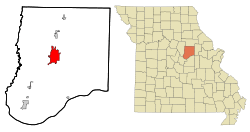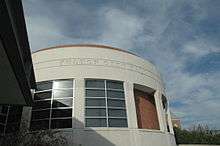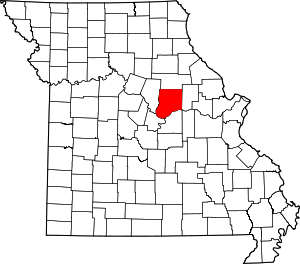Fulton, Missouri
Fulton is the largest city in and the county seat of Callaway County, Missouri, United States.[5] Located about 22 miles (35 km) northeast of Jefferson City and the Missouri River and 20 miles (32 km) east of Columbia, the city is part of the Jefferson City, Missouri, Metropolitan Statistical Area. The population was 12,790 in the 2010 census. The city is home to two universities, Westminster College and William Woods University; the Missouri School for the Deaf; the Fulton State Hospital; and the Fulton Reception and Diagnostic Center state prison.
Fulton, Missouri | |
|---|---|
| City of Fulton | |
Callaway County Courthouse in Fulton. | |
 Location of Fulton, Missouri | |
| Coordinates: 38°50′48″N 91°56′53″W[1] | |
| Country | United States |
| State | Missouri |
| County | Callaway |
| Founded | 1825 |
| Incorporated | March 14, 1859 |
| Government | |
| • Mayor | Lowe Cannell |
| Area | |
| • Total | 12.46 sq mi (32.28 km2) |
| • Land | 12.33 sq mi (31.93 km2) |
| • Water | 0.14 sq mi (0.35 km2) |
| Elevation | 764 ft (233 m) |
| Population | |
| • Total | 12,790 |
| • Estimate (2019)[4] | 12,596 |
| • Density | 1,021.66/sq mi (394.47/km2) |
| Time zone | UTC-6 (Central (CST)) |
| • Summer (DST) | UTC-5 (CDT) |
| ZIP code | 65251 |
| Area code(s) | 573 |
| FIPS code | 29-26182 |
| Website | Official website |

History
The first settlement in the county was in 1808 at Cote Sans Dessein along the Missouri River. Early leaders considered siting the first Missouri state capital in the territory between Wainwright and Tebbetts. Callaway County was organized in 1830 and was named after Captain James Callaway, who was killed by Indians. Elizabeth became the first county seat. Many of the villages and towns in the county today represent places where railroad stations existed in early years.
In 1861, word arrived that Union troops had advanced to a nearby county. Colonel Jefferson F. Jones, from eastern Callaway County, assembled troops to protect the county. Forces were limited as many were already defending the country, but Jones marched the troops eastward to meet the approaching companies.
The successful defense was merely an illusion. Tree logs, erected by the troops, resembled artillery in the shadows of campfires and deterred Union troops. Talks continued several days and secured a mutual ceasefire agreement between the United States of America and Callaway County. Elated from the successful defense, citizens proclaimed their county The Kingdom of Callaway, a reference that remains today.
Fulton, the largest city in Callaway County, was founded and became the county seat in 1825 but was not incorporated until March 14, 1859. The city was originally named Volney after Constantin François de Chassebœuf, comte de Volney,[6] but was changed to honor Robert Fulton, the engineer and inventor, two months after the initial Volney name in 1825.[7] Volney, New York is a town in Oswego County, New York which is also named for Volney. A village within the town of Volney is Fulton, New York which is also named for Robert Fulton.
The early residents of Fulton were from a predominantly southern culture. The coastal and upland southerners that settled on the land brought with them slaves and established an agricultural economy.
When the first history of Callaway County was compiled in 1884, the die had already been cast as far as the type of community Fulton was to be. The Missouri General Assembly had voted to establish an asylum for the insane in Fulton (February 26, 1847), the first mental health facility west of the Mississippi; the General Assembly agreed (February 28, 1851) to establish a school for the education of the deaf in Fulton; in 1842 the Presbyterian Church had opened a female seminary later known as Synodical College; in the fall of 1851 the Presbyterian Church established the all-male Fulton College, now known as Westminster College; and Fulton was the seat of county government. Winston Churchill made his famous "Sinews of Peace" (Iron Curtain) speech at Westminster in 1946.
The Christian Church moved its Orphan School to Fulton in 1890. Whether or not they were influenced by the already-existing colleges is not known, but Fulton's bid of $40,000 and the offer of 10 acres (40,000 m2) of land was surely a factor. The school, which had previously been located at Camden Point, Missouri, later became William Woods College for Women, which later became a Coed University, thus accepting men.
Novelist Henry Bellamann was born in Fulton in 1882, and grew up and attended college there. Fulton is said to have been Bellamann's model for the fictional town of the novel Kings Row, which generated questions about the resemblance it had to individuals and situations around the area.[8][9] In 1940, producers made a movie based on the book. The cast included Ann Sheridan, Robert Cummings, Ronald Reagan and Betty Field. The suit worn by Ronald Reagan in the film is on display at the Show Me Innovation Center offices of the Callaway Chamber of Commerce.
The M. Fred Bell Rental Cottage, M. Fred Bell Speculative Cottage, Brandon-Bell-Collier House, George Washington Carver School, Court Street Historic Residential District, Downtown Fulton Historic District, John Augustus Hockaday House, Pitcher Store, Robnett-Payne House, Westminster College Gymnasium, Westminster College Historic District, and White Cloud Presbyterian Church and Cemetery are listed on the National Register of Historic Places.[10][11]
Geography
The city is located in central Callaway County along U.S. Route 54 about 22 miles (35 km) northeast of Jefferson City and the Missouri River. Columbia is about 20 miles (32 km) to the northwest.[12]
According to the United States Census Bureau, the city has a total area of 12.40 square miles (32.12 km2), of which 12.26 square miles (31.75 km2) is land and 0.14 square miles (0.36 km2) is water.[13]
Demographics
| Historical population | |||
|---|---|---|---|
| Census | Pop. | %± | |
| 1870 | 1,585 | — | |
| 1880 | 2,409 | 52.0% | |
| 1890 | 4,314 | 79.1% | |
| 1900 | 4,883 | 13.2% | |
| 1910 | 5,228 | 7.1% | |
| 1920 | 5,595 | 7.0% | |
| 1930 | 6,105 | 9.1% | |
| 1940 | 8,297 | 35.9% | |
| 1950 | 10,052 | 21.2% | |
| 1960 | 11,131 | 10.7% | |
| 1970 | 12,248 | 10.0% | |
| 1980 | 11,046 | −9.8% | |
| 1990 | 10,033 | −9.2% | |
| 2000 | 12,128 | 20.9% | |
| 2010 | 12,790 | 5.5% | |
| Est. 2019 | 12,596 | [4] | −1.5% |
| U.S. Decennial Census | |||
2010 census
As of the census[3] of 2010, there were 12,790 people, 4,085 households, and 2,255 families living in the city. The population density was 1,043.2 inhabitants per square mile (402.8/km2). There were 4,602 housing units at an average density of 375.4 per square mile (144.9/km2). The racial makeup of the city was 83.4% White, 12.0% African American, 0.5% Native American, 1.2% Asian, 0.6% from other races, and 2.3% from two or more races. Hispanic or Latino of any race were 2.1% of the population.
There were 4,085 households, of which 28.5% had children under the age of 18 living with them, 36.3% were married couples living together, 14.2% had a female householder with no husband present, 4.7% had a male householder with no wife present, and 44.8% were non-families. 37.4% of all households were made up of individuals, and 14.2% had someone living alone who was 65 years of age or older. The average household size was 2.23 and the average family size was 2.93.
The median age in the city was 31.3 years. 17.4% of residents were under the age of 18; 21.6% were between the ages of 18 and 24; 27.4% were from 25 to 44; 21.2% were from 45 to 64; and 12.4% were 65 years of age or older. The gender makeup of the city was 54.8% male and 45.2% female.
2000 census
As of the census[14] of 2000, there were 12,128 people, 3,700 households, and 2,208 families living in the city. The population density was 1,072.3 people per square mile (414.0/km2). There were 4,131 housing units at an average density of 365.2 per square mile (141.0/km2). The racial makeup of the city was 81.26% White, 15.44% African American, 0.41% Native American, 1.06% Asian, 0.02% Pacific Islander, 0.38% from other races, and 1.43% from two or more races. Hispanic or Latino of any race were 1.09% of the population.
There were 3,700 households, out of which 28.9% had children under the age of 18 living with them, 40.9% were married couples living together, 14.8% had a female householder with no husband present, and 40.3% were non-families. 33.5% of all households were made up of individuals, and 14.9% had someone living alone who was 65 years of age or older. The average household size was 2.28 and the average family size was 2.90.
In the city, the population was spread out, with 18.0% under the age of 18, 20.0% from 18 to 24, 31.1% from 25 to 44, 16.9% from 45 to 64, and 14.0% who were 65 years of age or older. The median age was 33 years. For every 100 females, there were 129.8 males. For every 100 females age 18 and over, there were 134.8 males.
The median income for a household in the city was $32,635, and the median income for a family was $41,722. Males had a median income of $27,418 versus $21,663 for females. The per capita income for the city was $14,489. About 8.4% of families and 11.9% of the population were below the poverty line, including 16.1% of those under age 18 and 6.3% of those age 65 or over.
Government and infrastructure
Rosa Parks Center, a Missouri Division of Youth Services (DYS) center for incarcerated girls, is a former university dormitory,[15] located at William Woods University (WWU). It holds 10-12 girls at a time.[16] WWU students are involved with the center. DYS and WWU agreed to the joint project in 2000, and the center opened in January 2001.[17]
Education
Post-secondary
Westminster College and William Woods University are the two post-secondary institutions in the city. Fulton was formerly, from 1842 until its closing in 1928, the site of Synodical College, one of the earliest women's colleges in the United States.
Primary and secondary schools
Bartley Elementary (K–5), Bush Elementary (K–5), McIntire Elementary (K–5), Fulton Middle School (6–8) and Fulton High School (9–12) are part of the Fulton 58 School District.
St Peters Catholic School (K–8), and Kingdom Christian Academy (K–11) are both private schools.
Missouri School for the Deaf, a state school supervised under The Missouri Department of Secondary and Elementary Education (DESE), is also located in Fulton.
Public library
Fulton has a public library, a branch of the Daniel Boone Regional Library.[18]
Museums
The National Churchill Museum in Fulton commemorates the statesman and his Iron Curtain speech. The 1946 address built a legacy bringing to Westminster College world leaders: Lech Wałęsa, Margaret Thatcher, Harry S. Truman, Gerald R. Ford, Ronald W. Reagan, George H.W. Bush, Mikhail Gorbachev and NATO representatives.
With the removal of the Berlin Wall, Churchill's granddaughter acquired a section of it to create a sculpture, entitled "Break Through", to commemorate the Iron Curtain speech. Visitors view it on the quadrangle at Westminster College. The Memorial includes the Church of St Mary the Virgin, Aldermanbury. Craftsmen dismantled the structure in London, England and rebuilt it on the Westminster campus to mark Churchill's visit.
Museums and displays depict beginnings in the Kingdom of Callaway. The Fishback Museum spotlights history of the Missouri School for the Deaf. The Kingdom Expo and Antique Car Museum emphasizes transitions in transportation. Photos, genealogy research and history books headline the exhibit at the Historical Society. In addition, the Kingdom of Callaway Chamber of Commerce and Visitor Center features a display of "King's Row" memorabilia.
Notable people
- William F. Baker, structural engineer for the Burj Khalifa
- Morris Frederick Bell, architect
- Henry Bellamann, poet and author of Kings Row
- John Ferrugia, journalist
- Tony Galbreath, running back in the National Football League for the New Orleans Saints 1976–80, the Minnesota Vikings 1981–83, and the New York Giants 1984–87
- William Lincoln Garver, architect, author, and socialist politician
- Charlie James, Major League Baseball outfielder for the St. Louis Cardinals 1960–65
- John Jameson, politician
- Michael Kim, ESPN anchor and personality
- Bake McBride, Major League Baseball outfielder and 1974 National League Rookie of the Year
- Ron McBride, running back in the National Football League for the Green Bay Packers 1973
- Laura Redden Searing, also known as Howard Glyndon, deaf poet and writer
- Helen Stephens, 1936 Olympic Champion (The Fulton Flash)
References
- U.S. Geological Survey Geographic Names Information System: Fulton, Missouri
- "2019 U.S. Gazetteer Files". United States Census Bureau. Retrieved July 26, 2020.
- "U.S. Census website". United States Census Bureau. Retrieved 2012-07-08.
- "Population and Housing Unit Estimates". United States Census Bureau. May 24, 2020. Retrieved May 27, 2020.
- "Find a County". National Association of Counties. Archived from the original on 2011-05-31. Retrieved 2011-06-07.
- McMillen, Margot Ford (1994). Paris, Tightwad and Peculiar: Missouri Place Names. Columbia, Missouri: University of Missouri Press. p. 41. ISBN 0-8262-0972-6.
- Ramsay, Robert L. (1952). Our Storehouse of Missouri Place Names, p. 56. Columbia, Missouri: University of Missouri.
- Dictionary of Missouri Biography by Lawrence O. Christensen, University of Missouri Press, 1999
- Ball, Karen (December 13, 1987). "Fulton has change of heart over Kings Row". Associated Press via Los Angeles Times. Retrieved July 17, 2012.
- "National Register Information System". National Register of Historic Places. National Park Service. July 9, 2010.
- "National Register of Historic Places Listings". Weekly List of Actions Taken on Properties: 10/12/10 through 10/15/10. National Park Service. 2010-10-22.
- Missouri Atlas & Gazetteer, DeLorme, 1998, First edition, p. 38, ISBN 0-89933-224-2
- "US Gazetteer files 2010". United States Census Bureau. Archived from the original on 2012-07-02. Retrieved 2012-07-08.
- "U.S. Census website". United States Census Bureau. Retrieved 2008-01-31.
- Charton, Scott. "Missouri juvenile justice practices praised, and copied" (Archive). Associated Press. Monday March 7, 2005. Retrieved on December 23, 2015.
- "House Resolution No. 4910" (Archive). Missouri House of Representatives. Retrieved on December 23, 2015.
- "William Woods University (Fulton, MO) Rosa Parks Center" (). The Council of Independent Colleges (CIC). Retrieved on December 23, 2015.
- "Locations and Hours". Daniel Boone Regional Library. Retrieved 17 March 2018.
Further reading
- Lael, Richard L;. Brazos, Barbara; McMillen, Margot Ford. Evolution of a Missouri Asylum: Fulton State Hospital, 1851-2006 (University of Missouri Press, 2015)
External links
- Official website
- Historic maps of Fulton in the Sanborn Maps of Missouri Collection at the University of Missouri
